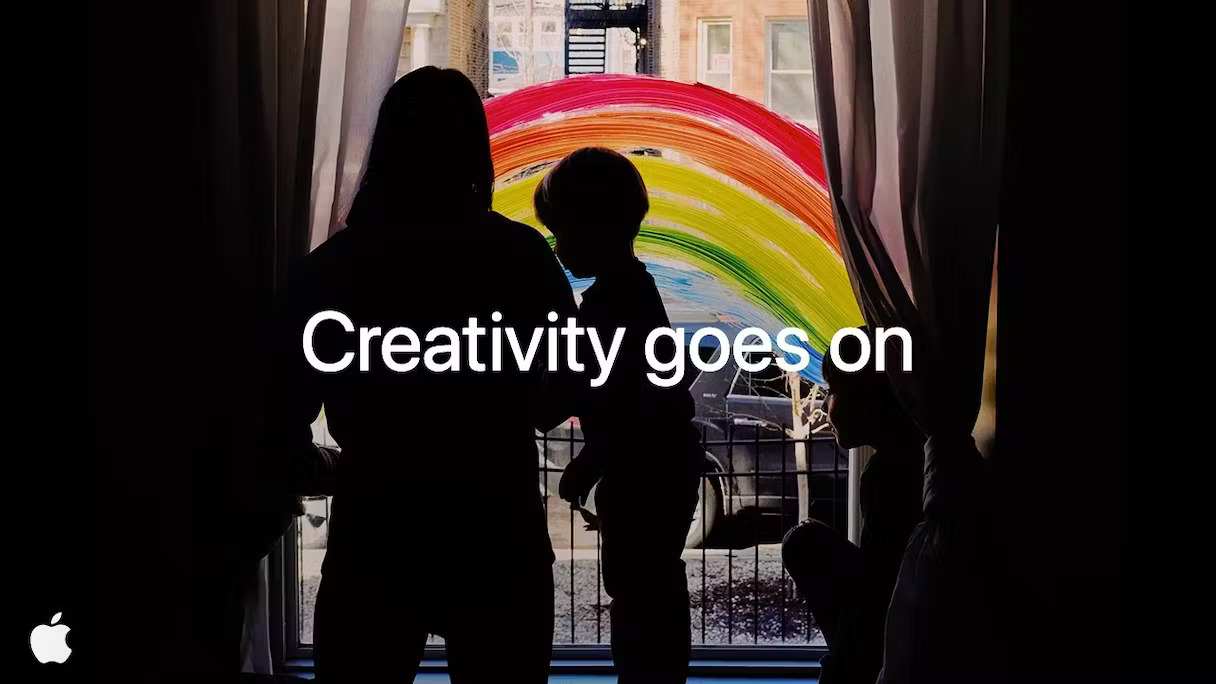Apple – “Creativity Goes On” – Prolific Creative Activity During the Quarantine

Apple was like a bright spot, establishing its reputation as a reliable, encouraging, and supportive companion.
“Creativity is just connecting things,” Steve Jobs famously stated. He was especially praising how having a wide range of life experiences might inspire new ideas. Jobs believed that you can’t think creatively if you don’t have “enough dots to connect.”
Being a technological trailblazer of his day, he was complimenting novel concepts through the prism of his time to remind his data-focused coworkers of the need to keep perspective. He did not want his people to think linearly.
What then occurs when a worldwide quarantine cuts off almost all of our normal means of communication? Is there a ceiling on imagination?
The proliferation of new connections, many of which Apple’s products have helped to enable, has not only prevented innovation from dying but has also helped it flourish.
Apple and its advertising agency, TBWA Media Arts Lab, collaborated on a new commercial that was a beautiful, understated ode to life during a period of quarantine, including videos of actual people, famous people, artists, and their families. Everyone is working to perfect a talent, distribute a gift, or materialize an idea.
When it comes to capturing the finest of our culture in times of crisis, “Creativity Goes On” is without peer. Even more remarkable is the fact that the whole process—from concept to final product—took just two weeks.
The commercial drew inspiration from earlier Apple projects like “Behind the Mac” and “Shot on iPhone.” Apple, however, was not only taking a far broader view of its goods this time around but was also, to its credit, playing down the importance of those items in favour of highlighting the achievements of the creative minds behind them.
Apple, unlike many other businesses, is not emphasizing sentiments of stoic unity in response to the COVID-19 pandemic. Apple’s willingness to participate in delicate cultural events pays well here, but it’s a hazardous approach that may produce resentment for a brand marketer who isn’t up to the job of striking the correct balance and tone.
The original version of the commercial was assembled throughout a weekend using clips sourced from all over the web. Due in large part to the enthusiastic reaction of the content producers when approached by the brand, the resulting draft would undergo surprisingly few revisions before becoming final.
70% of the material used in the initial rough edit was ultimately used in the final commercial. There were fewer edits along the road because of licensing issues, however, getting permission to use the final picture of Fred Astaire and Ginger Rogers was a bit of a hassle. Ads were regularly revised to include a more recent video that was discovered during the production process.
The Young Ebenezers’ “Asleep at the Parade” was another early pick that stuck with the commercial throughout the review process.
The spot’s production began in the latter days of March, and it premiered on April 10. While the ad’s release wasn’t as flashy as the way other marketers introduce new projects, it nonetheless made a strong first impression.
The ad features a slideshow of pictures and clips of people enjoying their free time at home. Everyone in the commercial appears to be keeping in contact, being creative, and maintaining a positive outlook despite the prevalence of social isolation. Of course, many famous people do this while using Apple devices, such as John Krasinski in his special “Some Good News” and Oprah Winfrey while using her Mac.
Nonetheless, the commercial’s heartfelt scenes include ordinary people like a little child taking a virtual ballet lesson or an adult doing yoga in front of a computer, or a dad teaching his two kids how to indoor surf. It’s a fleeting moment of happiness amid a time of dread.
Why did it work?
Here, Apple’s marketing effort shone like a beacon of hope amid the darkness of the epidemic. Hence, Apple established its reputation as a reliable, encouraging, and supportive companion in times of need.
The advertisement features more than just iPad and Mac users. There are certain moments when Apple products are not visible. In particular, these photographs aid Apple in promoting not just their product but also positivity and originality. And it produces very moving outcomes.
Such a move was not completely out of the field for Apple. It has more often than not promoted a philosophy or way of life than a tangible product.
Apple’s goal with this film was to go beyond simple product promotion. They attempted to encourage originality and optimism and maybe provide some with means of escape and survival.
Reference
https://blog.anthonythomas.com/ata-blog/apple-and-the-higher-purpose-of-marketing



